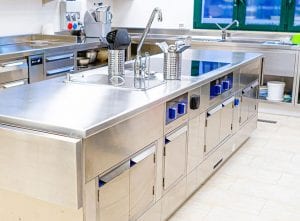When you buy commercial kitchen equipment, you tend to think that the purchase price of the appliance represents the whole cost. And although this mindset is partly correct, it fails to consider two important details:
1 – a standard commercial kitchen has an average lifetime of several years and during that time the appliances are worked very hard. The strain this puts on the appliances means they need regular maintenance, which is an additional cost, or the average lifetime is lowered. In any case, the purchase price is not the most effective way of assessing the overall cost of the appliance.
2 – commercial kitchen equipment is bought as a set of technologies needed to achieve a predetermined result, i.e. timely, proper serving of quality meals to customers. Buying appliances means buying a solution, not just items. Each time the appliance fails to achieve the desired result, a cost is incurred that is not considered in the purchase price: whether it is a monetary cost (repair or maintenance prices) or an intangible cost (dissatisfied, non-returning customers, bad word of mouth), it is not considered in the purchase price.
A cost-driven approach to buying commercial kitchen equipment consists of mainly assessing purchase prices; a performance-driven approach instead assesses the capability of the appliance to flawlessly function for the longest period of time.
Operation performance vs commercial kitchen equipment cost: the value of after-sales service
You can really see the difference between a cost-driven approach and a performance-driven approach when you consider the value of after-sales service.
From a costing point of view, after-sales service is a cost, and it is good as long as it comes at the lowest possible price. From a performance point of view after-sales service is as good as its capability to
- Extend the life of commercial kitchen equipment via
- Proper maintenance
- Correct repairs
- Provide original spare parts
- Boost commercial kitchen equipment performance by
- Providing proper accessories, consumables and chemicals
- Faster or even pre-emptive maintenance
Who wants kitchen equipment with a shorter lifetime, or longer back-to-operation times in the event of malfunction? No one, for sure. These issues are performance-related, and their importance is evident if you consider your commercial kitchen as a performance center.
If, on the other hand, you consider the kitchen as a cost center, those considerations will probably be second to the need to cut costs.
Considering after-sales service as a way to keep down costs
From a performance perspective, good after-sales service is certainly one way of cutting costs, as long as it lengthens the lifetime of appliances and improves their performance. Modern technology provides lots of opportunities for after-sales service to do just that:
- In connected kitchen appliances, supplier support teams can provide precious tips and tools, including on-line checking, remote control, as well as in-depth analysis to prevent breakdown and malfunction.
- An efficient service network can reduce intervention and back-to-operation time
- Data exchange can turn a single problem solved in a commercial kitchen into a solution applied to all the appliances of that kind in the whole supplier’s network (collective intelligence)
Choosing a supplier that can provide these services is one way to boost performance, and in so doing, to cut costs.
